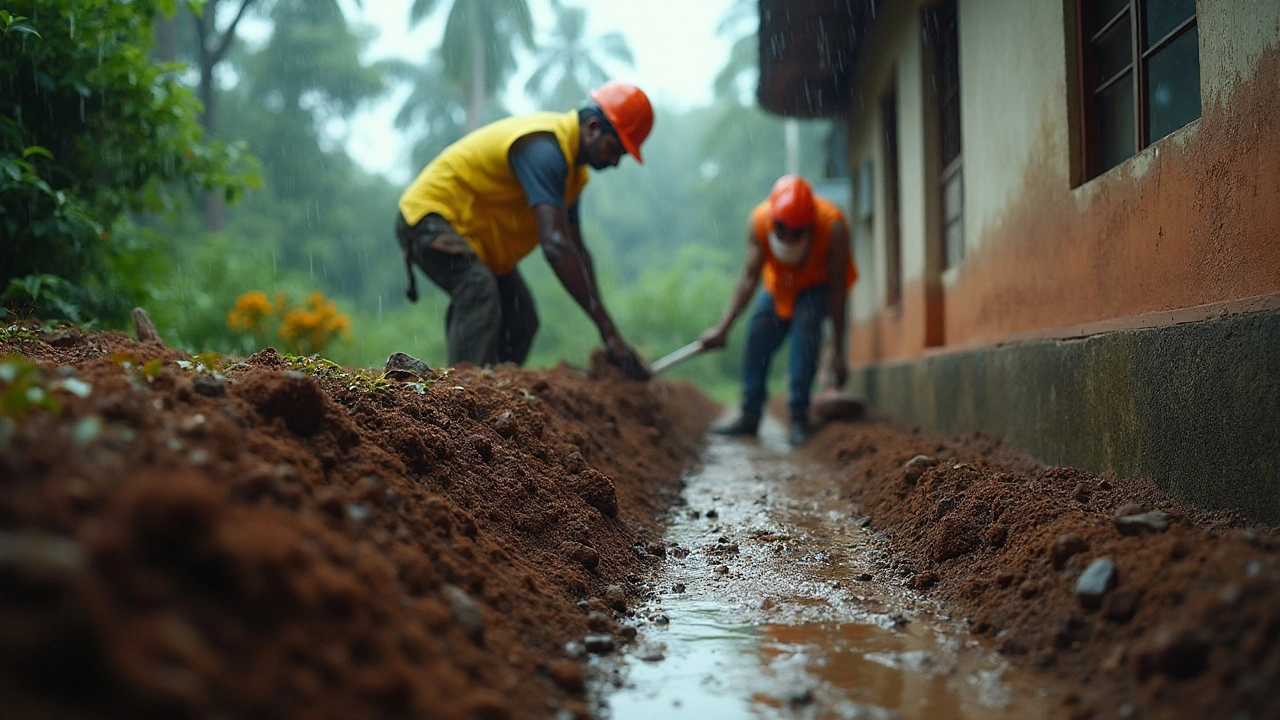Understanding Major Foundation Issues and Repair Solutions

When it comes to the stability and safety of a home, the foundation plays a crucial role. But like any part of a house, it can encounter problems that require attention. Understanding what constitutes a major foundation issue can help homeowners take timely action before these issues lead to more severe damage.
Look for signs that suggest something might be amiss with your home’s foundation. Cracks in walls or floors, doors that refuse to close properly, and sloping floors are all red flags. Sometimes, it's not just about age or wear and tear; underlying causes like soil erosion or improper drainage could be at play. Identifying these problems early can save homeowners from costly repairs down the road.
It's important to know how to properly assess the damage and what kind of repairs might be necessary. Different problems require different solutions, ranging from patching minor cracks to underpinning for more significant issues. Familiarizing yourself with these solutions and being proactive with maintenance can preserve the health and stability of your home for years to come.
- Recognizing Signs of Foundation Problems
- Common Causes of Foundation Issues
- Assessment and Diagnosis
- Types of Foundation Repairs
- Preventive Measures and Maintenance Tips
Recognizing Signs of Foundation Problems
The integrity of a home rests significantly upon its foundation, and identifying issues early can mean the difference between a simple fix and extensive repair work. To recognize these foundation issues, one must first familiarize themselves with the common symptoms that indicate something beneath the surface isn't as it should be. For instance, visible cracks in walls or floors often serve as the earliest indication, appearing as hairline fractures that may expand over time if ignored. These cracks can be especially prevalent around windows, doorways, or in corners where stress points naturally occur. The material of the foundation plays a role here as well, with concrete frequently displaying horizontal or stair-step patterns which can signal settlement or movement within the structural base.
Another noteworthy sign involves doors and windows that suddenly become misaligned. Homeowners might notice that doors no longer latch correctly or windows stick when trying to open or close them. This is often due to a shifting foundation which disrupts the original angles and alignments of the building’s structure. Similarly, floors that appear uneven or sloped are an ominous indicator. When walking from one room to another, a noticeable tilt can suggest underlying settling or uneven distribution of load-bearing points. Since construction practices and environmental conditions vary widely, these problems are sometimes misattributed to other factors, delaying necessary foundation repair.
A particularly insidious sign of foundation trouble can be moisture accumulation, which is often evidenced by damp basements or crawl spaces. High humidity levels or persistent water pooling in these areas should raise alarms. Such conditions not only foster mold growth but also indicate potential breaches in the home’s foundational barrier, possibly due to inadequate drainage or soil pressure against the walls. In climates where soil expands and contracts with moisture, these signs can be more severe, underscoring the need for swift action. Plumbing issues, like unexplained leakage or backed-up wastewater, are another telling sign, as shifting foundations may disrupt or damage the pipelines running beneath the house.
In the context of homeowner experiences, relying on stories from those who have faced these challenges can be enlightening. As one noted architect once observed,
"Small cracks tell stories of stress, but ignoring them can transform whispers into calamities." Understanding that these minor symptoms can evolve into significant issues motivates a proactive approach to home maintenance. By inspecting regularly and addressing these problems promptly, homeowners can protect their investment and avoid arduous repair undertakings.To further drive the prioritization of early detection, consider potential implications of these symptoms gone unchecked. For example, serious foundation issues can reduce the market value of a home and disqualify homes from certain insurance coverages until repairs are made, leading to additional financial stress. Rather than risking such outcomes, equipping oneself with the knowledge to identify the early warning signs lays the groundwork for preserving property integrity.
Common Causes of Foundation Issues
Every solid home rests on its foundation, but when problems arise, the root cause can often be traced back to a few common culprits. Understanding these foundation issues is the key to addressing them effectively. The soil beneath your house is often the silent contributor to these problems. Certain soil types, like expansive clay, can absorb large volumes of water, and during specific weather conditions, this can cause the soil to expand and contract. Such movement can lead to cracking or settling.
Beyond the soil, water is a relentless adversary. Poor drainage is frequently at the top of the list when it comes to foundation repair challenges. When water doesn't drain properly away from a house, it can pool around the foundation, causing erosion or even direct damage. Just as water can be problematic, so can the lack of it. Drought conditions can dry out the soil, leading to gaps between the soil and the foundation, which might result in instability.
Improper or incomplete construction can also leave a foundation vulnerable. Builders sometimes cut corners by not ensuring that the soil is adequately compacted before laying the foundation. This can create a weak spot that might not bear the load of the house efficiently. Significant weight added to a home post-construction, like an addition or heavy interior renovations, can also strain a foundation not originally designed for it.
"Some of the most persistent issues homes face today are rooted in poor planning and a lack of understanding of the local environmental conditions, especially in terms of soil and climate," notes Dr. Lara Falk, an esteemed structural engineer with years of experience in geotechnical studies.
Natural disasters are another notorious cause of foundation problems. Earthquakes, for instance, move the ground rapidly, and any structural weakness or fault can become an immediate danger. Similarly, floods can saturate and weaken even the most robustly constructed foundation, and hurricanes can combine these threats with wind-induced stress on the building itself.
Those living in older homes often encounter so-called 'settling,' where the house gradually and slowly sinks into the ground. Age and time take their toll on any structure, and as building materials inevitably break down, the stress of simple gravity can transform into a series of slow-motion earthquakes inside the structure itself, leading to uneven floors and cracked walls.
| Cause | Impact |
|---|---|
| Water or Poor Drainage | Erosion, foundation seepage |
| Expansive Soil | Cracking, heaving |
| Improper Construction | Weak spots, settling |
| Natural Disasters | Sudden shifts, destruction |

Assessment and Diagnosis
Evaluating the health of your house foundation really starts with being observant. The first step in diagnosing any potential issues involves conducting a thorough visual inspection of both the interior and exterior of your home. This is an area where you want to be meticulous, looking out for warning signs such as diagonal cracks on walls, gaps around window frames, or misaligned doors and windows that indicate your house may have shifted. Homeowners often overlook these signs, thinking they're just typical aging symptoms of a building, but they can actually be indicative of much larger foundation issues at play.
It's crucial to understand the soil conditions around your property too, as soil movement and erosion are common culprits behind many foundation ailments. A professional evaluation often includes a keen analysis of the type of soil your home sits on—some clays, for instance, can significantly expand or contract with moisture changes, causing the foundation to move. Due to this, it's recommended that any house experiencing unusual settling to undergo professional scrutiny to identify the root causes. The issue might not be the foundation itself, but rather how it interacts with its surroundings.
Foundation experts often employ a variety of tools and technologies to assess the scope of the problem. Instruments like laser levels or even more sophisticated sonar technologies can detect shifts or uneven surfaces that aren't visible to the naked eye. A structural engineer might be brought in to conduct this foundation repair assessment, providing a detailed report of the findings. In these analyses, factors such as the age of the house, historical records of the area’s climate, or even nearby construction activities are considered. They collectively paint a bigger picture of what might be causing the foundation to falter.
According to the International Association of Certified Home Inspectors, "minor foundation cracks, usually less than a quarter of an inch, are often purely cosmetic, while anything larger could indicate structural damage."
This speaks to the necessity of professional insight because what appears to be a small crack might belie deeper structural instability. One effective way to visualize the problem is through a detailed diagram or map of the foundation, noting any weaknesses or areas of concern. Such documentation not only helps in understanding the present situation but also acts as a reference point for any future assessments or foundation repairs.
Following this evaluation, the next logical step is engaging with a contractor specializing in this field who can interpret these findings and offer solutions. Recommendations might range from simple surface treatments to more involved methods like underpinning the foundation or installing piers. An accurate diagnosis aids in avoiding unnecessary repairs, saving time and resources while ensuring the longevity of your home.
Types of Foundation Repairs
Foundation repairs can vary greatly depending on the specific type of damage and the underlying causes. Understanding these repairs is essential for homeowners who want to maintain their property's integrity and value. One common method for addressing foundation issues is slabjacking. This approach involves pumping a grout mixture into the space beneath a sunken concrete slab to raise it back to its original position. It's particularly effective for large slabs, although not all situations may be suitable for this technique. Factors such as soil conditions and the extent of the sinking come into play when determining the appropriateness of slabjacking.
Another widely used repair method is underpinning. This technique involves strengthening and stabilizing an existing foundation by extending it deeper into more stable soil layers. Often, this involves the use of piers driven into the ground to provide additional support. Steel pier underpinning is a modern approach that utilizes steel piers drilled deep into the soil, which can offer a durable solution for homes in areas with unstable soil. However, it's crucial to consult with a structural engineer to determine if underpinning is the right course of action for your particular case, as every home and soil condition can be unique in its own way. A key consideration is always the long-term health of the structure and not just a quick fix.
Foundation repair options also include utilizing helical piers, which are ideal for lighter loads like porches or garages. These screw-like piers can be installed quickly with minimal disturbance to your property, offering an effective way to stabilize lighter structures. Additionally, carbon fiber reinforcement is gaining popularity for its ability to repair cracked walls without extensive excavation. This method uses carbon fiber strips adhered to the foundation walls, effectively counteracting tension and preventing further cracking. Unlike traditional methods, carbon fiber reinforcement is less invasive and offers an innovative approach to dealing with specific types of cracks.
"Foundations require tailored solutions; no one-size-fits-all, as each home faces unique challenges based on geological and environmental factors," says renowned structural engineer, Dr. Elaine Thompson. Such insights emphasize the importance of personalized assessment and repair strategies.
In some cases, patching cracks with epoxy or polyurethane foam injections may suffice for less severe structural damage. These injections fill in the cracks and solidify to restore integrity. While patching might help in the short term, it's often a temporary measure unless the root cause, like poor drainage or structural shifts, is addressed. For homes with moisture issues, installing or repairing French drains can be an effective preventive measure, helping to redirect water away from the foundation and minimizing potential future damage.
To illustrate repair choice complexity, consider the relevance of local climate changes. Areas prone to heavy rainfall may demand more robust drainage systems when undertaking foundation repair. Here's where a strategic combination of techniques proves invaluable. Homeowners who arm themselves with knowledge about various repair types are better equipped to consult professionals and ensure that an informed, economical decision is made for their circumstances. It’s a peace-of-mind investment in the longevity and safety of your home.

Preventive Measures and Maintenance Tips
Keeping your home safe and your investment sound involves regular checks and maintenance routines. One critical area that demands such sustained attention is the foundation. Preventing a potential problem before it starts is often the best strategy. Start by ensuring that the ground around your home slopes away from the foundation. This simple measure can prevent water from pooling around the base of your house, which can weaken the soil and affect foundational stability. Additionally, check the gutters and downspouts regularly. Clogged gutters can lead to overflowing water that puddles next to the foundation, exacerbating potential issues.
Another fundamental tip is maintaining consistent soil moisture levels, particularly in regions prone to dry spells. The foundation can shift or settle if the soil under your house expands and contracts excessively. Installing soaker hoses around the perimeter and using them judiciously during dry periods can be an effective strategy to prevent soil shrinkage. Meanwhile, landscaping choices can also play a role. Avoid planting trees too close to your home, as their roots can disturb the foundation. Instead, opt for shrubs and smaller plants that require less water and do not have invasive roots.
Regular inspection is key. Every few months, take a walk around your home paying close attention to any new cracks in walls, floors, or the foundation itself. These could be early signs of potential issues. If you're unsure what to look for, hiring a professional for an annual inspection isn't just prudent—it's an investment in your home's future. The cost of a regular check-up can set you back less than a major foundation repair later on. Encouragingly, a study from the Foundation Repair Association found that consistent inspections reduce the likelihood of major repairs by up to 35%.
"An ounce of prevention is worth a pound of cure," noted Benjamin Franklin, and it certainly holds true for home maintenance.
Sometimes, maintenance involves direct interaction with the foundation itself. It's wise to seal any existing cracks to prevent moisture ingress, particularly in wet climates. The process is straightforward and involves using a specialized sealant applied directly to the crack. This creates a moisture barrier and helps to ensure structural integrity. Meanwhile, consider installing a proper drainage system if you frequently face waterlogging issues. French drains, for instance, are a popular choice and work by redirecting water away from your home's base using a system of buried pipes.
Ultimately, staying proactive and informed can make all the difference when it comes to foundation repair and maintenance. Record any changes you observe and discuss them with a professional, as it provides a clear history of minor issues that may indicate larger ones down the road. Remember, maintaining the value of your home demands effort, but it's markedly simpler and less costly than addressing severe structural damage. Keep these tips in mind, and your home's foundation will continue to stand firm for generations.

